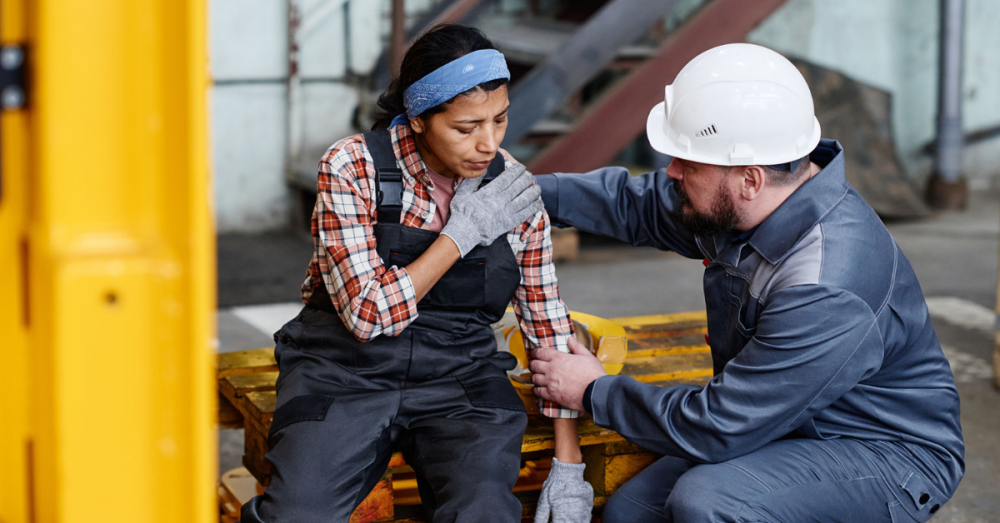
How Most Employees Get Hurt at Work
Employees can get hurt on the job anytime, anywhere. While some types of employment – construction, law enforcement, healthcare – increase the risk of suffering on-the-job injuries, no workers are immune from the possibility of getting hurt while on the clock. Even the most presumably safe work environment like an office comes with the risk of harm.
The most recent available data from the Occupational Safety and Health Administration (OSHA) reveals there were 2.8 million nonfatal workplace injuries and illnesses. That means that for every 100 employees on the job, 2.8 of them became sick or were hurt while performing their official duties.
Here are some of the most common ways employees get hurt at work and what you can do if you suffer a workplace accident or injury that leaves you with a temporary or permanent disability.
1 – Overexertion
Transportation and warehousing employees are more prone to this kind of injury than other workers. According to the National Safety Council, the most at-risk age group is people between 45 and 64 years old. The injury rate is 27 per 10,000, with back injuries the most common type of overexertion trauma. About 31 percent of all workplace injuries for 2019 – the most recent year for which data is available – were due t0 overexertion.
It can be difficult to prevent overexertion injuries. There are some measures you can take to reduce the risk. Never bend forward and lift heavy objects from that position. Draw strength from your legs, instead. Never reach or twist when lifting. Lastly, do not be afraid to ask for assistance if an item is too heavy for you to manage on your own.

2 – Falls, slips, and trips
Workers in the agriculture, transportation and warehousing industries 55 years old and older are most at risk for this type of workplace injury. According to the National Safety Council, there are 23.9 incidents each year per every 10,000 full-time workers. Sprains, strains, and tears are the most frequent type of injury from falls, slips, and trips.
As with overexertion, falls, slips, and trips can be difficult to prevent. Employees should wear work-appropriate shoes that provide extra traction. Employers must take the following precautions to help protect workers:
- Apply anti-skid adhesive tape to trouble spots for extra grip.
- Avoid obstacles in common areas.
- Clean up spills immediately.
- Display “wet floor” signs to warn of dangers when appropriate.
- Install proper lighting in all work areas.
- Make immediate repairs of stairs and flooring when needed.
- Use moisture-absorbent mats with beveled edges at all entrances.
3 – Contact with equipment
Agriculture, construction, transportation, and warehousing are the most vulnerable industries for these kinds of workplace accidents and injuries since they use heavy equipment. Cuts, lacerations, and punctures are the most common injuries for workers in these careers. The most at-risk age group is 16 to 24, with 25.8 percent of all workplace injuries each year happening because of contact with equipment.
Employees can help protect themselves by wearing the proper personal protective equipment for their environments. Walk behind moving equipment when possible and be aware of your surroundings. Lastly, never operate equipment you are not properly trained to use.

4 – Transportation incidents
Nearly 50,000 on-the-job accidents and injuries involve motor vehicle accidents. As part of their job duties, some employees must make deliveries or visit clients off-site. Employees who drive for work encounter inclement weather, faulty automotive equipment, and negligent drivers. Any of these or other factors can increase the risk of being involved in a vehicle accident that causes injuries.
Businesses should stress safe driving practices for all employees who operate work or personal vehicles while carrying out their official job duties. Employees must commit to following safe vehicle operation guidelines.
5 – Exposure to harmful substances
More than 36,000 workers are exposed to harmful substances in the workplace that cause illness and injury. Hazards that fall into this category include air and water pressure changes, electricity, oxygen deficiency, radiation, and temperature extremes. Workers employed by the service industry are more likely to suffer these kinds of workplace injuries and illnesses, followed by leisure and hospitality employees.
OSHA requires employers to provide notification of all harmful substances on a work site. They must provide training for all employees in the safe handling of these materials. OSHA also outlines specific protocols businesses must take when a worker is exposed to or injured by one of these substances.
6 – Violence
Workplace violence is becoming more prevalent. More than 44,000 injuries each year can be attributed to violent outbursts in places of employment. Violence can happen following disputes between coworkers, or a domestic violence issue may follow an employee to the workplace. Employers must provide violence training to all employees that include strategies for prevention and how to de-escalate a violent situation. Communication channels for reporting concerns must be established and employees should feel comfortable sharing information.
Seeking professional help for workplace injuries
When someone else’s negligence or deliberate actions cause illness or injury to others, they can be held accountable. Workplace injuries can leave you unable to work and cause you to rack up expensive medical bills for ongoing treatment. While worker’s compensation is available to most employees, it often is not adequate for meeting all financial needs. An experienced workplace accident injury attorney can help. Ron Archibeque has more than 20 years of experience securing fair compensation for victims. Contact us today to schedule a free case review to determine if you are eligible for additional damages from the parties responsible for your illness or injury.